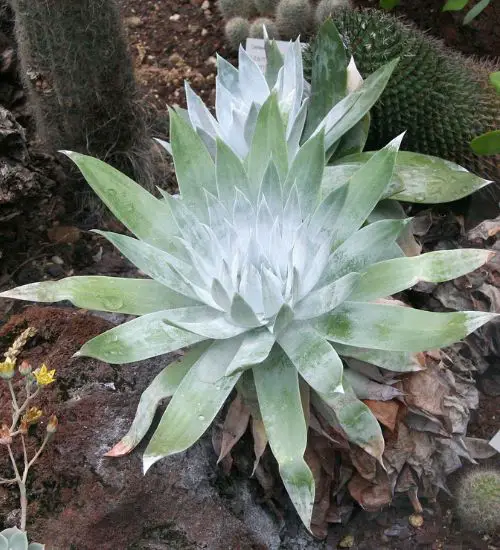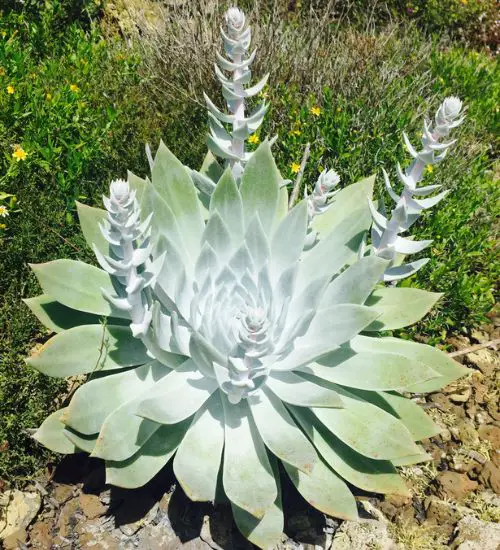Sun: Full sun to partial sun
Water: Below average watering needs for a succulent
Temperature: Zone 9a from 20° F to 25° F (-6.7 ° C to -3.9° C) to Zone 11b from 45° F to 50° F (7.2° C to 10° C)
Winter Survival: Not cold hardy
Propagation: stem cuttings
Flower: in the Spring and early Summer
Flower Type: white or cream
Toxic: Toxic to humans and animals
Dormant: summer
Space Requirement: Indoors & Outdoors
Common Problems: Plants may rot if overwatered, pests
Where to buy Dudleya anthonyi?
Basc Care for Dudleya anthonyi
Watering
Watering for Dudleya anthonyi is a simple task. It requires Below average watering needs for a succulent.
Can you water your succulent more than what its need? The answer is yes and no. In extreme conditions, you can water your plants more often when you notice the soil is completely dry.
Fertilizing
Only feed this succulent during its active growing seasons which means winter. Use the right fertilizer applied in the right amounts. Applying half-strength balanced fertilizer every month or so is recommended for optimal results.
Do not fertilize during summer as the plant is dormant.
Sun & Location Requirements for ""San Quintín liveforever, Anthony's Liveforever""
Dudleya anthonyi requires full sun to partial sun in order to grow its best. If your plant isn't getting at least 6 hours of direct sunlight each day, consider moving it outdoors during the summer months or near a south-facing window throughout the year. With enough light, you'll have a healthy and happy succulent!
As per this succulent profile, it is only able to stay healthy when the environment temperature is above the range of zone 9a from 20° F to 25° F (-6.7 ° C to -3.9° C).
When temperatures drop below freezing, it is important to take precautions to protect Dudleya anthonyi from the cold. Insulating and providing adequate drainage for the plant are key elements in helping it survive winter weather. Wind and sun exposure should also be minimized to prevent frost damage.
Any succulents in the group will need a medium space to grow. You can place your pot at your table or window. Since this plant needs more space than mini succulents, you should consider do not plant them together with other succulents/plants.
Dudleya anthonyi also benefits from some indirect light throughout the day as well, so make sure you give it enough space to soak up light without becoming too exposed to heat.
Propagation
One of the easiest and most popular ways to propagate Dudleya anthonyi is by stem cuttings. This method involves cutting a stem from an existing succulent and planting it in soil to grow a new plant.
Toxicity

All parts of Dudleya anthonyi are considered to be poisonous, and should never be ingested. Even contact with the sap can cause serious skin irritations in humans and animals, so it’s important to wear gloves when handling them.
Pests and Diseases
Dudleya anthonyi can be affected common pests and diseases like most of the other succulents such as aphids and mealybugs.
If you do spot any of pest signs, you can treat your succulent using below methods.
- Aphids: quarantine, clean infected plants, soapy water.
- Mealybugs: quarantine, clean infected plants, soapy water.
Besides that, to prevent serious health issues from happening, keep your succulent in a well-ventilated area and check it regularly for any signs of pests or health problems.


